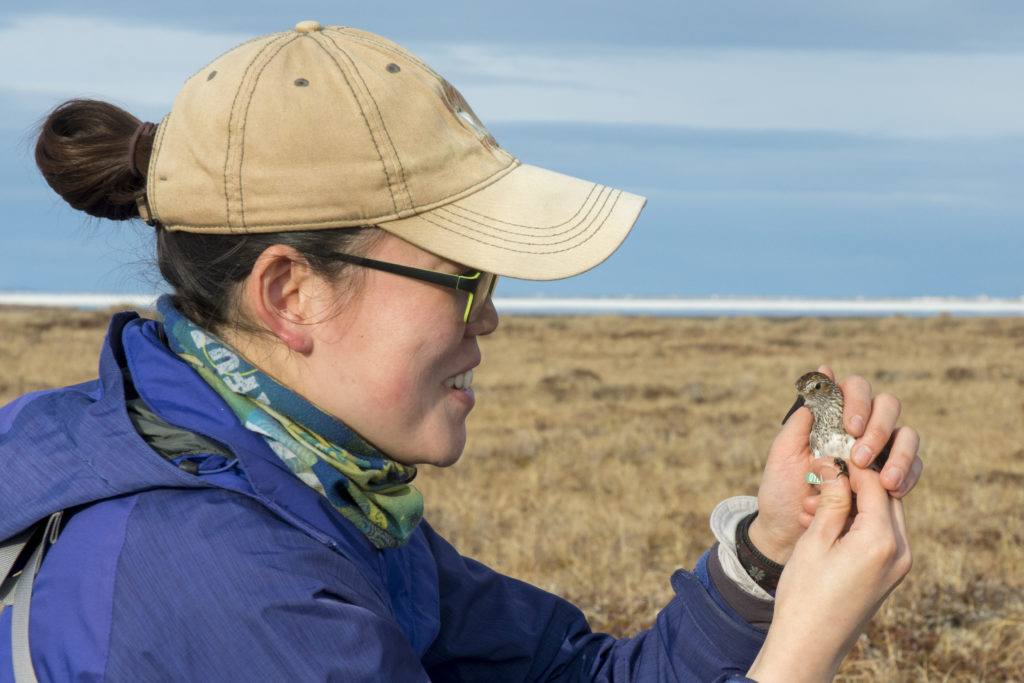By Emily L. Weiser, David Payer, Brett K. Sandercock, and Richard B. Lanctot
Linked paper: Annual adult survival drives trends in Arctic-breeding shorebirds but knowledge gaps in other vital rates remain by E.L. Weiser, R.B. Lanctot, S.C. Brown, H.R. Gates, J. Bêty, M.L. Boldenow, R.W. Brook, G.S. Brown, W.B. English, S.A. Flemming, S.E. Franks, H.G. Gilchrist, M. Giroux, A. Johnson, S. Kendall, L.V. Kennedy, L. Koloski, E. Kwon, J. Lamarre, D.B. Lank, C.J. Latty, N. Lecomte, J.R. Liebezeit, R.L. McGuire, L. McKinnon, E. Nol, D. Payer, J. Perz, J. Rausch, M. Robards, S.T. Saalfeld, N.R. Senner, P.A. Smith, M. Soloviev, D. Solovyeva, D.H. Ward, P.F. Woodard, and B.K. Sandercock, The Condor: Ornithological Applications.
Bird migration is one of the most spectacular wildlife phenomena on the planet, and this is especially true of shorebirds that migrate thousands of miles every year. Unfortunately, many populations of shorebirds are declining due to human modification of habitats along migratory routes and in overwintering areas. The exact causes of these losses are difficult to study, because birds from a single population may fan out across multiple countries or continents during their seasonal movements. However, even when these birds are congregated on their remote Arctic breeding grounds, researchers face challenges from the brief breeding season, often-inclement weather, and the presence of brown bears and polar bears — not to mention the mosquitoes. Many species also breed across Arctic North America, Europe, and Asia, necessitating carefully planned, broad-scale coordinated efforts to study a representative sample of the population.
The Arctic Shorebird Demographics Network (ASDN) was conceived to address the need to document population trends and identify the root causes of declines. The ASDN brought together an impressive team of over 20 partners, including ornithologists from government agencies, universities, and non-profit organizations (see our paper for a full list of cooperators and funders, including National Fish and Wildlife Foundation, the Neotropical Migratory Bird Conservation Act, and the Arctic Landscape Conservation Cooperative, among others). Together we secured funding for new field sites, standardized methodology across existing projects, and compiled field data from 16 sites across Alaska, Canada, and Russia into a unified database. We measured seasonal patterns in reproductive success, evaluated the effects of environmental and ecological conditions on reproduction, and estimated annual adult survival rates of shorebirds breeding on our study plots. Six focal species were particularly well represented in our dataset: American Golden-Plover, Dunlin, Semipalmated Sandpiper, Western Sandpiper, Red-necked Phalarope, and Red Phalarope.
The broad-scale work of the ASDN culminated in our new paper in The Condor: Ornithological Applications. Using the demographic rates we’d calculated and other information available in the literature, we built a population model that predicts population trajectories for our six focal species. Our population model allows us to evaluate which demographic rates have the strongest influence on changes in population size and thus represent the most important priorities for conservation actions. We found that annual adult survival rates were strongly linked to population trends. Annual survival rates were much lower in the arcticola subspecies of Dunlin than in our other study species, and our model predicted strong population declines for this subspecies that were consistent with estimates from previous population surveys, indicating an urgent need to improve adult survival rates to halt declines of arcticola Dunlin.

Our model also highlights the uncertainty remaining around estimates of many demographic rates for these species. For example, we were able to find previous estimates of renesting propensity (the likelihood that birds will attempt to nest a second time if their first nest fails) and survival rates of chicks and juveniles for only a few species. Available estimates also often showed high uncertainty that affected trend estimates and resulted from variation among sites and years, low site fidelity in some species, and difficulty in resighting banded birds. Further study will help to better quantify the poorly known parameters and reduce uncertainty, thus providing better guidance for wildlife managers working with these populations.
In addition to the central goal of quantifying shorebird demographic rates across a wide array of sites, the ASDN facilitated or contributed to many other projects to support shorebird conservation, including:
- Tracking migration routes and timing in Semipalmated Sandpipers,
- Testing for effects of individual markers and tracking tags on demographic rates,
- Describing relationships between shorebird breeding parameters and climate,
- Evaluating whether breeding is optimally timed to provide young chicks with the most abundant food (invertebrates),
- Describing the composition and establishment of shorebird gut microbiota,
- Evaluating mercury exposure in shorebirds,
- Demonstrating bird-assisted dispersal of moss spores between hemispheres,
- Using feathers to measure stress in wintering shorebirds, and
- Describing incubation patterns in biparental shorebirds.
and additional projects with results forthcoming:
- Tracking migration routes in Dunlin and American Golden-Plovers,
- Describing the distribution of arctic invertebrates,
- Testing for relationships between invertebrate phenology and weather, and
- Testing for the presence of avian malaria in shorebirds.
The success of the ASDN is a tribute to the dedication of our international team of partners and demonstrates that broad collaborative efforts, while logistically challenging, can provide a great return on investment in the study and conservation of highly migratory, widespread species such as Arctic-breeding shorebirds.

COMMENTS